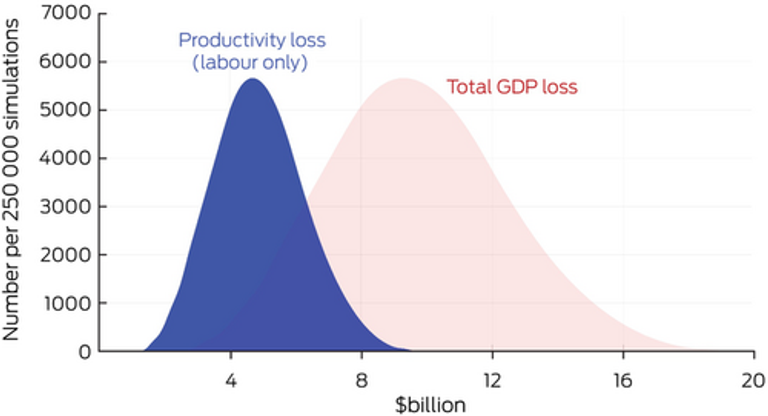ABSTRACT
Objective
To estimate the number of people in Australia with long COVID by age group, and the associated medium term productivity and economic losses.
Study design
Modelling study: a susceptible–exposed–infected–recovered (SEIR) model to estimate the number of people with long COVID over time following single infections, and a labour supply model to estimate productivity losses as a proportion of gross domestic product (GDP).
Setting
Australia, 2022–2024.
Main outcome measures
Estimated number of people infected with severe acute respiratory syndrome coronavirus 2 (SARS-CoV-2) during 2022–2023 (based on serosurvey data) who have long COVID, 2022–2024, by age group; estimated GDP loss during 2022 caused by reduced labour supply attributable to long COVID.
Results
Our model projected that the number of people with long COVID following a single infection in 2022 would peak in September 2022, when 310 341–1 374 805 people (1.2–5.4% of Australians) would have symptoms of long COVID, declining to 172 530–872 799 people (0.7–3.4%) in December 2024, including 7902–30 002 children aged 0–4 years (0.6–2.2%). The estimated mean labour loss attributable to long COVID in 2022 was projected to be 102.4 million (95% confidence interval [CI], 50.4–162.2 million) worked hours, equivalent to 0.48% (95% CI, 0.24–0.76%) of total worked hours in Australia during the 2020–21 financial year. The estimated mean GDP loss caused by the projected decline in labour supply and reduced use of other production factors was $9.6 billion (95% CI, $4.7–15.2 billion), or 0.5% of GDP. The estimated labour loss was greatest for people aged 30–39 years (27.5 million [95% CI, 16.0–41.0 million] hours; 26.9% of total labour loss) and people aged 40–49 years (24.5 million [95% CI, 12.1–38.7 million] hours; 23.9% of total labour loss).
Conclusion
Widespread SARS-CoV-2 infections in Australia mean that even a small proportion of infected people developing long COVID-related illness and disability could have important population health and economic effects. A paradigm shift is needed, from a sole focus on the immediate effects of coronavirus disease 2019 (COVID-19) to preventing and treating COVID-19 and treating long COVID, with implications for vaccine and antiviral policy and other mitigation of COVID-19.

